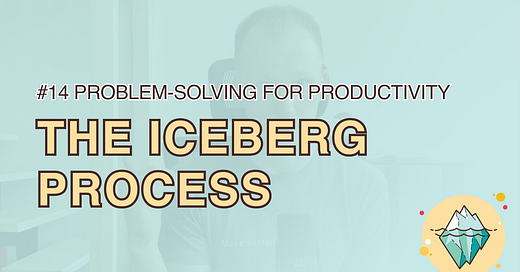
Hey stranger,
In this episode, I explain how to apply problem-solving skills to be more productive by identifying the right problem behind the task that somebody wants you to do.
If you prefer watching, you can find the YouTube video here. If reading is your thing, then enjoy the transcript below.
Welcome to The Daily Recall show. I'm your host, Vasili.
Today you will learn how to apply expert problem solving skills to task management.
This is a very real problem you have to deal with every day.
I've had people coming to me and saying: "You know, the stuff that you're talking about is great. And all this methods and models and thought processes are absolutely great but they have nothing to do with me. I'm not launching spaceships to Mars, I'm not inventing a new steam engine and stuff like that."
So I thought it would be great to give you guys a practical demonstration of what it means to actually know how to solve problems. And I picked productivity because that’s what everybody wants. Everybody wants to do more stuff. To make more money. To have more free time. Everybody wants it and very few people have it.
So it's a very interesting problem that we can explore from this problem solving skills perspective.
Here's the first idea that I want you to understand about productivity.
When we do serious problem-solving stuff, we never start from a problem as-is. Because the initial definition of a problem is almost never the right one. We have to spend some time identifying the right problem to solve before jumping into finding a solution.
But for some reason that is not clear to me, people don’t think that way about task management. Whenever they get a task thrown at them they immediately run to do it.
So I’ve come up with a simple four-step process to help myself deal with this tendency to rush and do things without thinking about them.
The first step is to clearly define what it is that the world is throwing at me and what has to be done about it.
Whenever a task shows up, I clearly define what is it. And tasks don’t show up in neat packages. They come in all sorts of ways - an email, an idea from the shower, a facebook comment from my friend, etc. They are all inputs that come from the world.
Here's an example. A friend reached out yesterday and asked to help her brainstorm ideas for a problem she has in her startup. She sent me a message: "hey could you help me brainstorm ideas for this problem I have?" This is the input that came from the world. And that’s step one of the four-step process; to clearly identify what has to be done - "to brainstorm ideas about a friend's project."
The second step is to identify if there's anything bigger behind the task.
The cool thing about precise definition of a task is from its high suggestive value. I immediately identified that this input is not actually a task, it's a project. Because I won’t be able to help her by doing just one thing - "brainstorming ideas on paper" - and a definition of a project is "any outcome that has to be achieved within a year that requires more than one step to achieve." So I turned this task - "to brainstorm ideas about a friend's project" into a project - "to help my friend solve problem X in her company."
The third step is to identify the problem that this project is supposed to solve.
This is extremely useful because when you understand the function, the problem of the project, you can actually come up with a different solution to it. And this new solution might be way faster, simpler and easier than the original project that you've come up with. So in my case, a friend wanted to help me brainstorm ideas with her. And if I just went ahead and did that, that’d be me solving the problem as-is. But I leveled up a little bit and realized that it's not about me spending 10 minutes with her brainstorming ideas. This is about me helping her to solve the problem that she has in her startup. So that's step three.
And the fourth step is to define the right problem to solve.
In my case, I realized that brainstorming is not actually the right thing to do because it works only for easy things like designing a new package and brings no value at all for complex problem solving. And by choosing to brainstorm ideas - and inviting me to help her - she picked the wrong problem to solve in the first place.
It's like if you were playing chess against Magnus Carlsen. You can brainstorm some moves but that won’t save your ass if you don’t know how to play. You need some big guns here.
In my last video I explained that you don’t go from a sailboat to a steam-powered ship by adding more sails of different sizes and colors and shapes. That’s not the right problem to solve. The right problem is to identify a better way to generate energy so that the boat can move faster, right?
When you do this four-step process and get to the right problem to solve, you get more results with less time. Most people think about this productivity game as of doing more stuff. That's not the case at all. It's about identifying the right problem to solve.
Thank you very much for reading and see you tomorrow.
This transcript has been edited for clarity.














Share this post